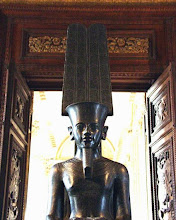Pyramid's Secret Doors to Be Opened

From Discovery Channel:
"Doors will soon open to reveal one of the mysteries of the Great Pyramid in Giza, Dr. Zahi Hawass, chief of Egypt's Supreme Council of Antiquities, told Discovery News in an exclusive interview.
Hawass, one of the world's leading Egyptologists, said he will show what lies behind secret doors inside the 4,500-year-old pharaonic mausoleum by the end of this year.
"Finally, people all over the world will know what is behind the second door in the southern shaft and the third door in the northern shaft," Hawass said.
Built in 2550 B.C. for the pharaoh Cheops, also known as Khufu, the Great Pyramid is the largest of a family of three pyramids on the Giza plateau, on the outskirts of Cairo.
The last remaining wonder of the ancient world has lost little of its original height of 481 feet, and contains 3.4 million cubic yards of material. Its base covers an area of 13.1 acres, which could accommodate the cathedrals of Florence, Milan, London's St. Paul's and Rome's St. Peter's and still have plenty of space.
The monument has long been rumored to have hidden passageways leading to secret chambers, and archaeologists have puzzled over the meaning of four narrow shafts deep inside the pyramid since they were first discovered in 1872.
Two shafts, extend from the upper, or "Kings Chamber" exit into open air. But the lower two, one on the south side and one on the north side in the so-called "Queen's Chamber" disappear within, deepening the pyramid mystery.
Widely believed to be ritual passageways for the dead pharaoh's soul to reach the afterlife, these 8-inch square shafts remained unexplored until 1993, when German engineer Rudolf Gantenbrink sent a robot through the southern shaft.
After a steady climb of 213 feet from the heart of the pyramid, the robot had to stop in front of a mysterious limestone slab adorned with two copper handles.
Nine years later, Hawass performed an investigation of the southern shaft on live television. As the world held its breath, a tomb-raiding robot pushed a camera through a hole drilled in the copper handled door — only to reveal another door.
The following day, Hawass sent the robot through the northern shaft. After crawling for 213 feet and several sharp bends, the robot came to an abrupt halt in front of another limestone slab.
As with the Gantenbrink door, the stone was adorned with two copper handles."I dedicated my whole life to study the secrets of the Great Pyramid and I must say that these doors create many exciting questions. It is intriguing that the door in the northern shaft and the first door in the southern shaft are equidistant from the queen's chamber.
"Moreover, they are very similar, as they both feature the same copper handles," Hawass said.
Speculation abounds that the shafts might lead to a secret chamber which might contain everything: a cache of papyri, a statue of Pharaoh Khufu, or even his real tomb.
"This month I am going to choose the team that is going to work with me on this project. It will be either from Singapore or Hong Kong," Hawass said.
Hawass did not specify whether inspections into the shafts have already been carried or whether further robotic investigations are necessary.
"I can only say that this year I will reveal the secrets of the Great Pyramid doors," Hawass told Discovery News."






